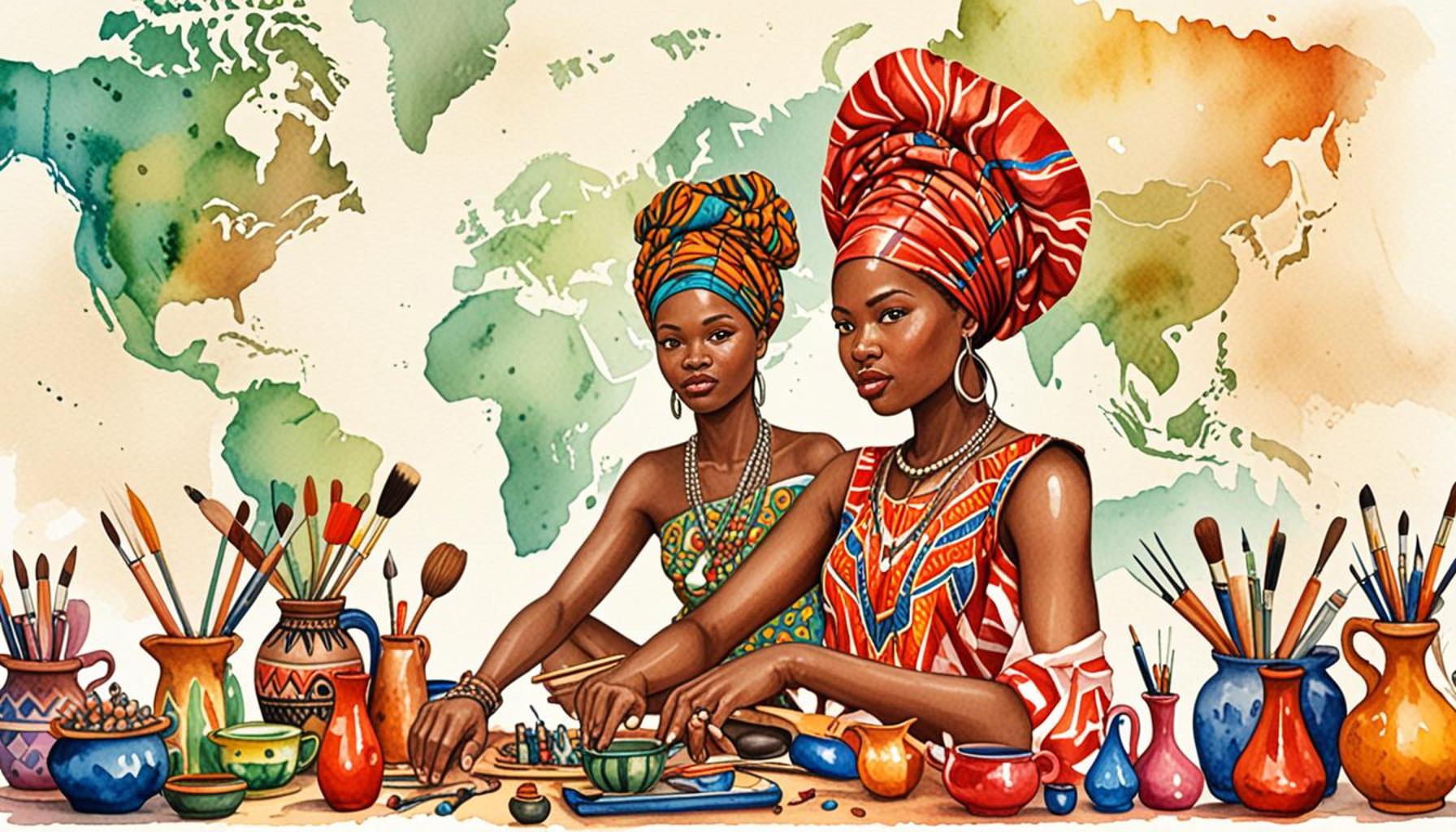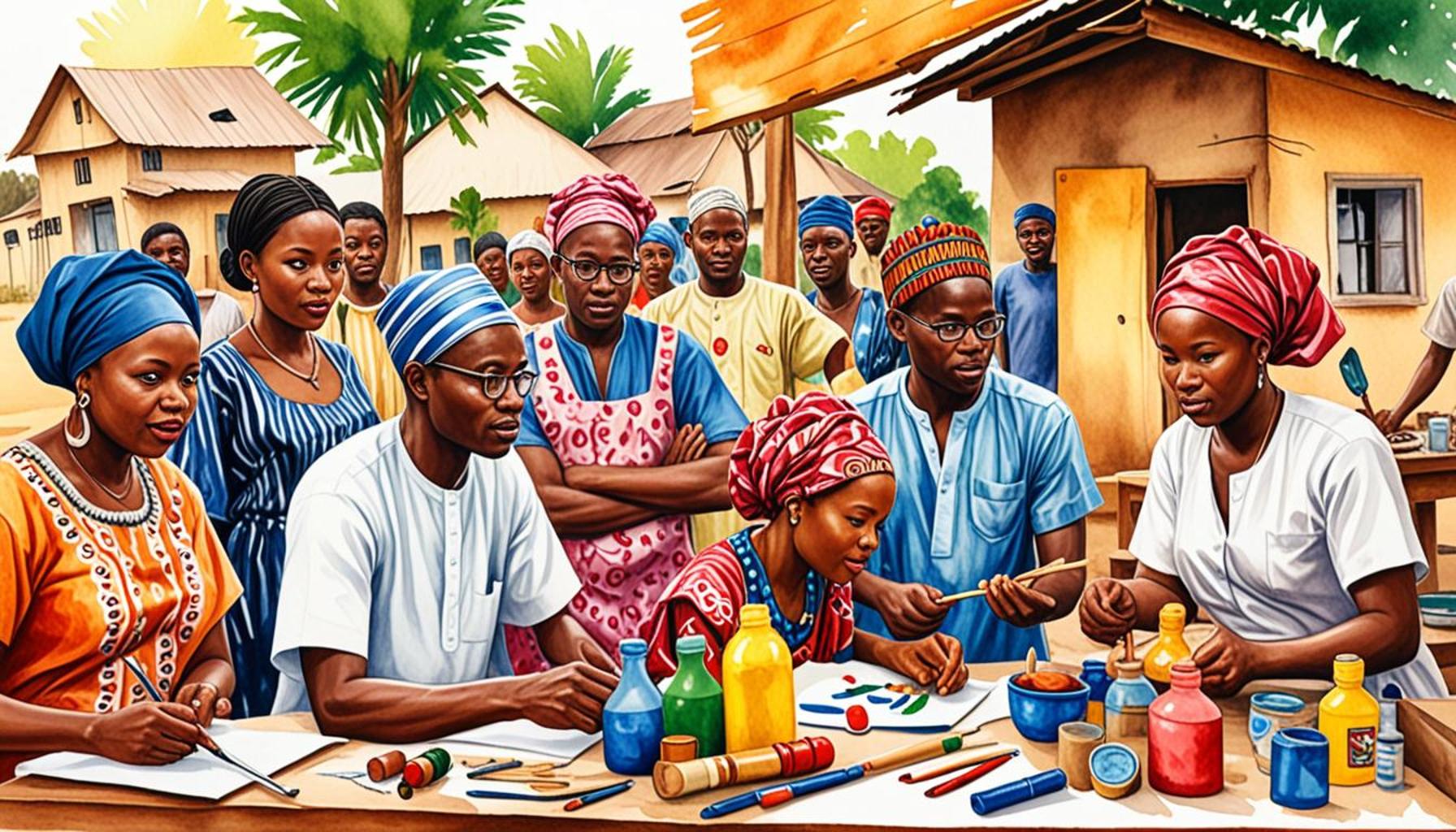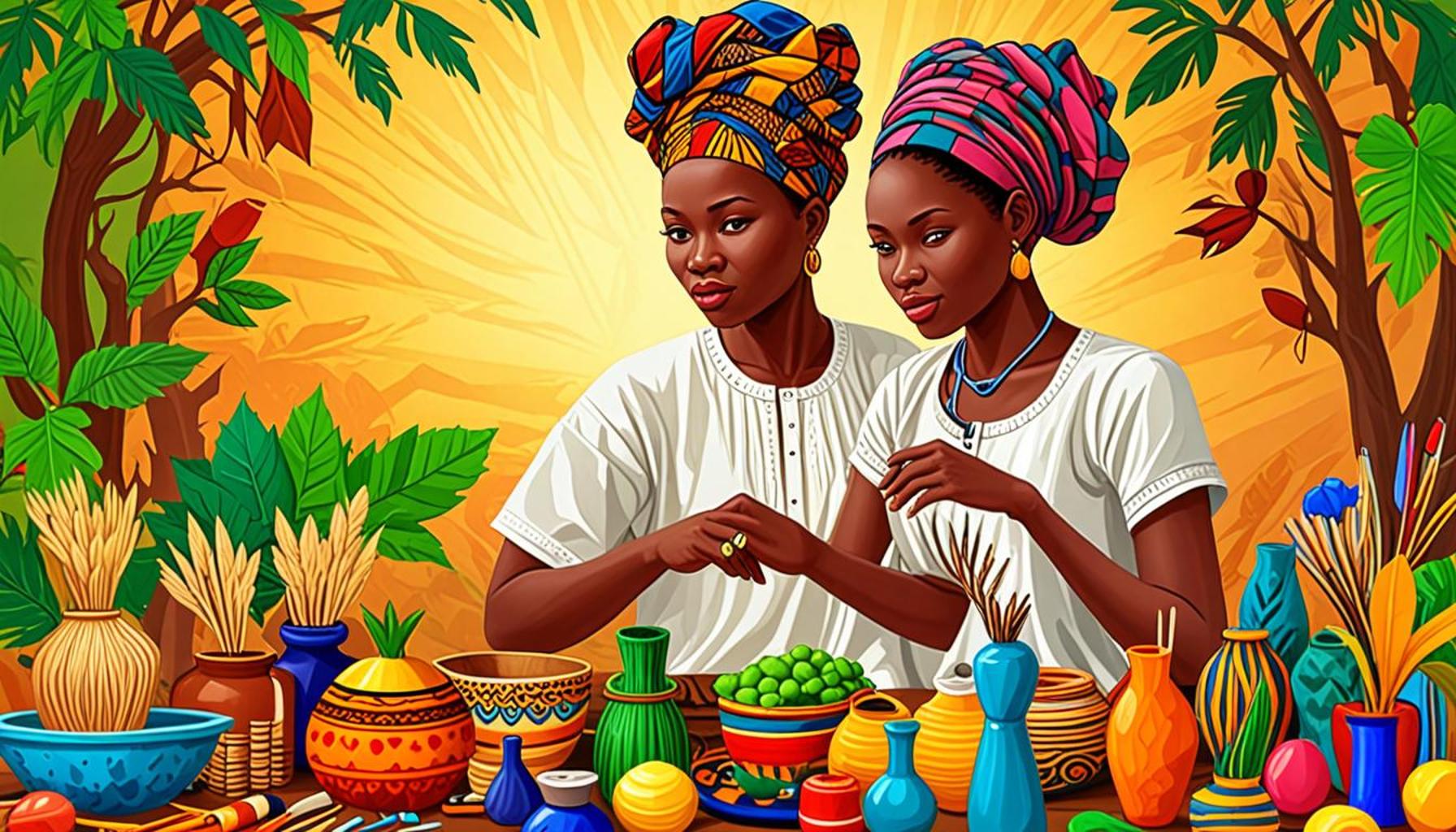The Influence of Globalization on Innovation Trends in Nigerian Handicrafts

Exploring the Transformation of Nigerian Handicrafts
The dynamics at play in the world today highlight a unique intersection between cultural heritage and modern innovations in craftsmanship. In Nigeria, this transformation is especially pronounced as artisanal practices have begun to flourish under the influence of globalization. Traditional crafts, which have long been a representation of Nigeria’s diverse culture, are now adapting and changing, enabling artisans to thrive in a competitive market both locally and globally.
One of the notable aspects of this evolution is the integration of modern techniques in production processes. For instance, craftsmen who once relied solely on manual tools are now using electric lathes, digital sewing machines, and 3D printing technology to create intricate designs with greater precision. This not only enhances product quality but also speeds up production times, allowing artisans to meet growing demand efficiently. A prime example is the use of computer-aided design (CAD) in textile production, enabling the creation of contemporary patterns that appeal to international tastes.
The materials used in Nigerian handicrafts have also diversified significantly. Artisans are now experimenting with unconventional materials such as recycled plastics, metals, and even locally sourced organic materials to create unique pieces that resonate with today’s environmentally conscious consumers. Take the example of artisans in Lagos who craft beautiful jewelry from discarded bottles, merging sustainability with artistry and attracting buyers who value eco-friendly products.
In addition to materials, the landscape of Nigerian handicrafts is being reshaped by global collaborations. Partnerships between local artisans and international designers have become increasingly common, allowing for cultural exchange and the infusion of fresh ideas. These collaborations often result in innovative products that capture the essence of Nigerian culture while appealing to wider markets. Events like the Lagos Fashion and Design Week frequently showcase such partnerships, highlighting the craftsmanship behind clothing and accessories that push the boundaries of traditional aesthetics.
Furthermore, the advancement of technology has led to a vast market expansion for artisans. Online platforms like Etsy, Instagram, and local websites have become vital channels for artisans to showcase their work. This digital presence allows them to reach a global audience, increasing their sales and visibility while maintaining their cultural identity. Artisans who once sold only at local markets now find their products in homes around the world, leading to a new appreciation for Nigerian craftsmanship.

These evolving trends illustrate how globalization is not only changing the way artisanal products are made but also the narrative around them. By blending tradition with modernity, Nigerian craftsmen are not just preserving their heritage; they are re-defining it, creating a unique tapestry of cultural expression that resonates in the contemporary marketplace. As we delve deeper into these trends, it becomes clear that the future of Nigerian handicrafts is bright, filled with endless possibilities and new horizons for artisans across the nation.
LEARN MORE: This related article may interest you
Innovation as a Catalyst for Growth in Nigerian Handicrafts
The influence of globalization on Nigerian handicrafts has ushered in a new era of innovation that is fundamentally altering traditional practices. As artisans adapt to global market trends, the integration of modern technologies and international collaborations is significantly enhancing their craft. This transformation can be seen in several key areas that are reshaping the landscape of Nigerian handicrafts.
Embracing Modern Technologies
Artisans are increasingly embracing modern technologies to refine their production processes. The shift from entirely manual techniques to incorporating advanced machinery has enabled craftsmen to produce high-quality goods more efficiently. For example, the use of laser cutting in woodwork has allowed artisans to achieve intricate patterns that were previously impossible to create by hand. Moreover, services that support small-scale businesses, such as online tutorials and workshops, have provided artisans with the necessary skills to leverage these technologies effectively.
Experimental Approaches to Material Use
Globalization has also encouraged artisans to venture beyond traditional materials, prompting a wave of experimentation that caters to evolving consumer preferences. Many Nigerian artisans are now utilizing a variety of materials that enhance their creativity while appealing to modern aesthetic sensibilities. This trend includes:
- Utilizing materials like reclaimed wood and metal to craft stunning furniture and décor items.
- Incorporating beads and textiles from international vendors to create statement jewelry that stands out on the world stage.
- Experimenting with the fusion of traditional and contemporary fabrics, such as combining local tie-dye with imported silks, leading to innovative fashion lines.
Such experimentation not only enriches the artisan’s portfolio but also creates a unique selling proposition that resonates with a wide range of consumers, especially those who are environmentally conscious.
Strengthening Global Networks
The interconnectedness afforded by globalization has enabled Nigerian artisans to establish global networks that enhance their visibility and market reach. Events like the African Fashion Week in Lagos and various expos serve as platforms for artisans to showcase their work to international audiences, leading to increased demand and collaboration opportunities. These interactions often result in joint ventures that merge local artisanal skills with international market trends, resulting in products that are both culturally rich and commercially viable.
This shift in focus from purely local markets to a broader global stage has fostered a sense of community among artisans. By sharing ideas and resources, they are not only improving their craft but also ensuring the survival of traditional techniques that might otherwise fade away. The rise of cooperative societies among craftsmen further illustrates this trend, as artisans pool resources to improve their production and marketing capacities.
As we explore these innovative trends further, it becomes clear that globalization has not merely affected how handicrafts are made; it has inspired a re-examination of what it means to be a Nigerian artisan in a globalized world. As these changes unfold, they offer a promising horizon for both artisans and the rich culture they represent.
| Advantage | Impact |
|---|---|
| Access to Global Markets | Increased opportunities for local artisans to reach customers worldwide, helping them to diversify their buyer base. |
| Cultural Exchange and Inspiration | Influence from global trends fosters innovation in traditional craftsmanship, leading to unique products that appeal to modern consumers. |
The ongoing process of globalization has brought a significant shift in the landscape of Nigerian handicrafts, where traditional artisans are now embracing novel innovations. These craftspeople leverage their cultural heritage while integrating modern techniques that resonate with contemporary audiences. The convergence of cultural influences fosters a unique identity, where age-old practices reflect the dynamism of the global market.Additionally, the accessibility of digital platforms allows artisans to showcase their craftsmanship beyond geographical constraints. By tapping into e-commerce and social media, Nigerian artisans can share their exquisite textiles, pottery, and beadwork with an international audience, generating interest and appreciation for their work.Moreover, international collaborations and training initiatives have emerged, equipping local artisans with skills to adapt their products for a global clientele. This synergy between tradition and modernity not only revitalizes Nigerian handicrafts but also promotes cultural heritage on a global scale, ensuring sustainability and growth in the competitive marketplace. As the world becomes more interconnected, the future of Nigerian handicrafts looks promising, marked by innovation, creativity, and rich cultural expression.
SEE ALSO: Click here to read another article
Redefining Market Strategies and Consumer Engagement
As the marketplace expands beyond local boundaries, Nigerian artisans are discovering new market strategies that enhance their connection with consumers both domestically and internationally. The necessity to adapt to global trends has led to a more nuanced understanding of consumer behavior, which in turn is driving innovative marketing techniques.
Leveraging Social Media and E-commerce
In the age of digital transformation, social media and e-commerce platforms have emerged as essential tools for artisans looking to penetrate international markets. Platforms such as Instagram, Facebook, and Twitter serve as virtual galleries, allowing artisans to showcase their creations while attracting a wider audience. For example, the hashtag campaigns showcasing #NigerianHandicrafts have gained momentum, facilitating connections with potential buyers across the globe.
Additionally, e-commerce platforms like Jumia and Etsy have provided artisans with the means to market their products directly to consumers. This shift from traditional sales models to online marketplaces significantly reduces overhead costs associated with brick-and-mortar stores, allowing artisans to price their products competitively. This digital presence not only democratizes access to the marketplace but also helps artisans craft personalized stories around their creations, which engages consumers on a deeper emotional level.
Creating Eco-conscious Brands
Another remarkable trend driven by globalization is the increasing consumer demand for eco-conscious and sustainable products. Increasingly, Nigerian artisans are aligning their business practices with environmental responsibility, which is integral to attracting an environmentally aware market segment. Artisans are utilizing upcycled materials and promoting traditional crafts that support sustainable practices.
- For instance, artisans in areas like Ibadan and Kano have joined hands to create upcycled bags and accessories from discarded materials, demonstrating craftsmanship while addressing waste management issues.
- Furthermore, initiatives like the “Made in Nigeria” campaign have gained traction, urging artisans to promote local products that reflect sustainable practices, thus appealing to the growing market of conscious consumers.
These innovations not only help artisans adapt to changing market trends but also contribute to strengthening Nigeria’s cultural identity as a hub of sustainability in handicrafts.
Diversifying Product Offerings
Globalization has encouraged Nigerian artisans to explore and expand their product offerings, venturing into areas that combine traditional craft with modern aesthetics. The fusion of local artistry with global trends has led to the creation of distinctive products that appeal to a diverse array of consumers.
Take, for instance, the booming market for traditional adire textiles that have been reimagined into contemporary fashion wear. By collaborating with modern designers, artisans are able to include traditional techniques in clothing that target both local and global markets. This blend of old and new showcases the versatility of Nigerian handicrafts and aids artisans in carving a niche for themselves in the competitive global fashion industry.
Furthermore, the growth of industries such as interior design has opened avenues for artisans to create home décor items that reflect Nigeria’s rich heritage while adhering to international design standards. Items such as woven baskets, handmade pottery, and carved sculptures are being designed to cater to the tastes of homeowners worldwide, effectively driving export opportunities.
This creative evolution driven by globalization offers a glimpse into the future of Nigerian handicrafts, highlighting how innovation can amplify cultural heritage while engaging with an ever-changing global marketplace.
ADDITIONAL INSIGHTS: Expand your understanding here
Conclusion: Embracing Innovation in a Globalized World
The journey of Nigerian handicrafts in the age of globalization reveals a tapestry woven with the threads of tradition, innovation, and adaptability. As artisans embrace the challenges presented by an increasingly interconnected world, they not only refine their crafting techniques but also broaden their horizons by embracing digital marketing and sustainable practices. This dual focus enables them to captivate an audience far beyond local markets.
Social media and e-commerce platforms serve as vital conduits, connecting artisans with consumers who seek authenticity and originality. The rise of eco-conscious brands reflects a growing awareness among consumers, pushing artisans to align their crafts with environmentally sustainable practices. By melding traditional artistry with contemporary aesthetics, artisans are charting innovative paths, allowing their products to thrive in both local and international landscapes.
Furthermore, the diversification of product offerings illustrates the dynamic nature of Nigerian handicrafts, showcasing the ability to resonate with global consumer trends while maintaining cultural integrity. Artisans are not merely survivalists in a changing marketplace; they are pioneers, innovating and carving niches that celebrate their heritage while contributing to a vibrant cultural economy.
In essence, the influence of globalization serves as both a challenge and an opportunity for Nigerian artisans. It compels them to innovate and to actively participate in the global conversation around handicrafts, making it crucial for stakeholders to continue supporting these artisans. As we look ahead, the potential for growth appears boundless, encouraging a deeper appreciation for the rich cultural narratives embedded within Nigerian handicrafts. The future is bright, and the global stage awaits.


